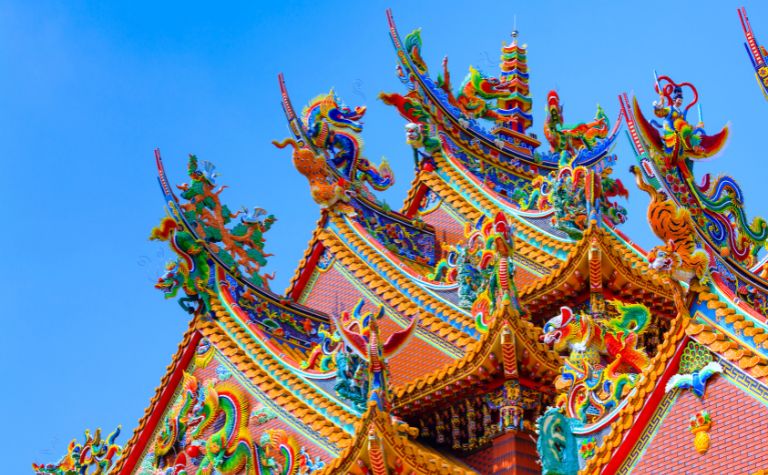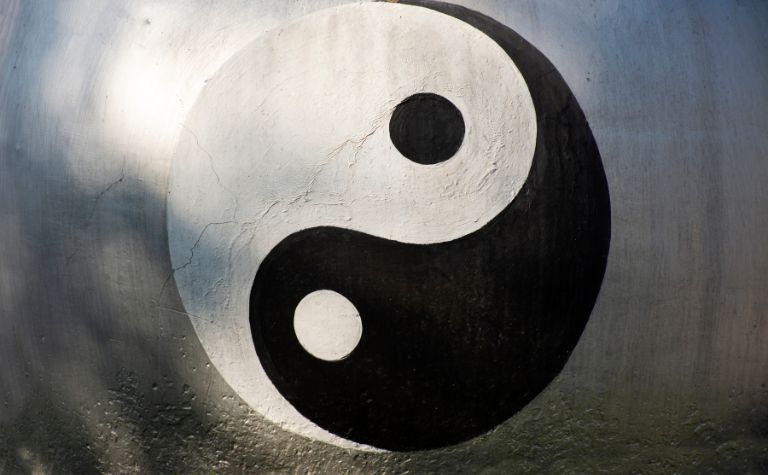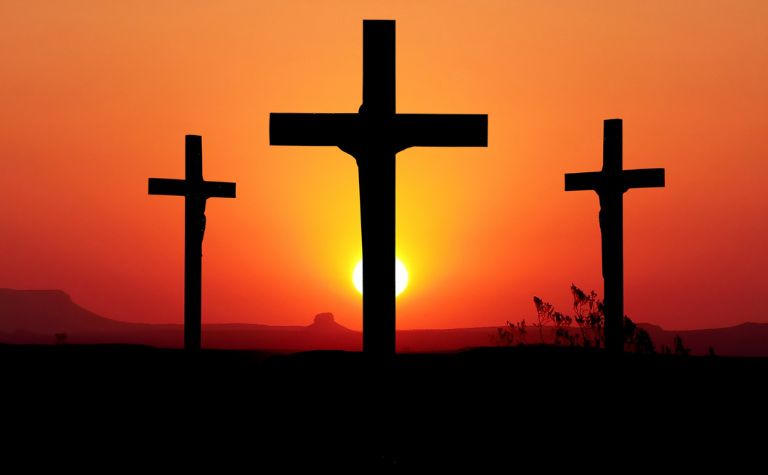Christianity and Taoism are two of the world’s major religions, each with its own unique beliefs, practices, and history.
While Christianity originated in the Middle East and is based on the teachings of Jesus Christ, Taoism emerged in China and is rooted in the philosophy of Laozi.
This article will explore the key similarities and differences between these two religions, examining their sacred texts, beliefs, practices, and historical development.

Comparing Christianity and Taoism: An Overview
“Christianity” comes from the Greek word “Christos,” meaning “anointed one,” referring to Jesus Christ, with the suffix “-ianity” denoting a belief system.
“Taoism” derives from the Chinese word “Tao” (or “Dao”), meaning “the Way,” with the suffix “-ism” indicating a philosophical or religious system.
| Aspect | Christianity | Taoism |
|---|---|---|
| Size | Approximately 2.3 billion adherents | Approximately 12-20 million adherents |
| Date Started | Around 1st century AD | Around 4th century BC |
| Founder | Jesus Christ (central figure), Apostles (founders) | Laozi (traditionally attributed) |
| Key Beliefs | Belief in one God (Trinity: Father, Son, Holy Spirit); Jesus Christ is the Son of God and Savior; Salvation through faith in Jesus Christ; Resurrection of Jesus Christ | Belief in the Tao (the Way) as the ultimate reality; Balance and harmony with nature; Emphasis on simplicity and non-action (wu wei); Cultivation of inner peace and spiritual insight |
| Key Practices | Prayer, Worship services, Reading the Bible, Baptism, Communion (Eucharist) | Meditation, Tai chi and qigong (physical exercises), Feng shui (harmonizing with the environment), Traditional Chinese medicine and herbalism |
| Divisions | Roman Catholicism, Eastern Orthodoxy, Protestantism | Philosophical Taoism, Religious Taoism, Folk Taoism |
| Central Location | Vatican City (Catholicism) Various locations for other denominations | China (origin and central location) |
| Sacred Texts | The Bible (Old and New Testaments) | Tao Te Ching (Daodejing) Zhuangzi I Ching (Yijing) |
Who was Laozi?
Laozi was an ancient Chinese philosopher and writer, traditionally considered the founder of Taoism. He is credited with authoring the Tao Te Ching, a foundational text of Taoist philosophy.
Laozi’s teachings emphasize living in harmony with the Tao, an underlying principle that governs all existence.
What’s the difference between philosophical and religious Taoism?
Philosophical Taoism focuses on the teachings of ancient texts like the Tao Te Ching, emphasizing harmony with the Tao and a natural, simple life.
Religious Taoism involves rituals, deities, and practices for spiritual cultivation and immortality. While both share core concepts, they differ in their practices and beliefs.

Contrasting Christian and Taoist Beliefs
| Christianity | Taoism | |
|---|---|---|
| God or gods | One God, existing in three persons (Trinity): Father, Son (Jesus Christ), and Holy Spirit | The Tao, an impersonal ultimate reality; various deities and spirits in religious Taoism |
| The universe | Created by God; a temporary existence that will be transformed in the end times | A manifestation of the Tao; a dynamic balance of opposites (yin and yang) |
| Ultimate reality | God is the ultimate reality; eternal, omnipotent, omniscient, and omnipresent | The Tao is the ultimate reality; an unchanging, underlying principle that governs all existence |
| Human beings | Created in the image of God; inherently sinful due to the Fall of Adam and Eve | Part of the natural order; inherently good but can be led astray by desires and societal influences |
| The problem with the world | Sin, resulting from the Fall of Adam and Eve; leads to suffering, injustice, and separation from God | Imbalance and disharmony; caused by straying from the Tao and natural order |
| The solution to the problem | Salvation through faith in Jesus Christ; repentance and forgiveness of sins | Returning to the Tao; living in harmony with nature, simplicity, and non-action (wu wei) |
| The afterlife | Heaven (eternal life with God) for the righteous; Hell (eternal separation from God) for the unrighteous | Varied beliefs; some Taoists seek immortality, while others focus on living in harmony with the Tao in this life |
What is the Trinity in Christianity?
The Trinity in Christianity is the belief that God exists as three persons in one essence: the Father, the Son (Jesus Christ), and the Holy Spirit. Each person is distinct yet fully God.
What does yin and yang mean in Taoism?
In Taoism, yin and yang represent the dual forces of the universe. Yin is associated with passivity, darkness, and femininity, while yang represents activity, light, and masculinity.
They are interdependent and complementary, creating balance and harmony in the natural world. The interaction of yin and yang shapes all existence.

The Practices of Christianity and Taoism
| Practice | Christian Practices | Taoist Practices |
|---|---|---|
| Prayer | Central to worship; personal communication with God | Used in rituals and ceremonies; often directed to deities and spirits |
| Worship Services | Regular gatherings for communal worship, prayer, and Bible readings | Rituals and ceremonies honoring deities, ancestors, and natural forces |
| Reading Sacred Texts | Reading and studying the Bible (Old and New Testaments) | Reading and studying texts like the Tao Te Ching, Zhuangzi, and I Ching |
| Dietary Practices | Varies by denomination; some observe fasting or abstain from certain foods | Dietary practices based on traditional Chinese medicine; some Taoists observe fasting or vegetarianism |
| Rituals | Baptism, Communion (Eucharist), Confirmation, Marriage, Anointing of the Sick | Offerings to deities and spirits; rituals for purification, protection, and blessings |
| Symbols | Cross, fish, dove, bread and wine, lamb | Yin-yang symbol, trigrams and hexagrams (I Ching), images of deities |
| Moral and Ethical Conduct | Following the teachings of Jesus Christ; emphasis on love, forgiveness, and charity | Following the Tao; emphasis on simplicity, harmony, and non-action (wu wei) |
| Physical Practices | Some Christians practice meditation or contemplative prayer | Tai chi and qigong (physical exercises); meditation and breathing practices |

The Sacred Texts of Christianity and Taoism
“Bible” comes from the Greek word “biblia,” meaning “books.” It refers to the collection of sacred texts in Christianity.
“Testament” derives from the Latin “testamentum,” meaning “covenant” or “agreement.” The “Old Testament” contains texts before Jesus, while the “New Testament” includes texts about Jesus and his teachings.
| Aspect | Christian Sacred Texts | Taoist Sacred Texts |
|---|---|---|
| Name of Texts | The Bible | Tao Te Ching, Zhuangzi, I Ching |
| Number of Books | 66 books (39 in the Old Testament, 27 in the New Testament) | Tao Te Ching (1 book), Zhuangzi (1 book), I Ching (1 book) |
| Language of Composition | Hebrew, Aramaic, Greek | Classical Chinese |
| Date of Composition | Between 1400 BC and 100 AD | Between 6th and 3rd centuries BC |
| Authorship | Various authors, including prophets, apostles, and other leaders | Traditionally attributed to Laozi (Tao Te Ching), Zhuangzi (Zhuangzi), and unknown authors (I Ching) |
| Themes | God’s relationship with humanity, salvation through Jesus Christ, moral and ethical conduct | The Tao (the Way), balance and harmony with nature, simplicity and non-action (wu wei) |
| Role in Worship | Central to worship services, sermons, and Bible studies | Used in rituals, meditation, and philosophical study |
| Interpretation | Interpreted through the teachings of Jesus Christ and the Church | Interpreted through the teachings of Taoist masters and sages |

10 Significant Events in Christian and Taoist History
| Christian Events | Taoist Events |
|---|---|
| 1. Birth of Jesus Christ (circa 4-6 BC) | 1. Composition of the Tao Te Ching (circa 4th century BC) |
| 2. Crucifixion and Resurrection of Jesus Christ (circa 30-33 AD) | 2. Composition of the Zhuangzi (circa 3rd century BC) |
| 3. Conversion of Paul the Apostle (circa 33-36 AD) | 3. Establishment of the Way of the Celestial Masters (circa 2nd century AD) |
| 4. Council of Nicaea (325 AD) | 4. Development of Taoist alchemy and immortality practices (circa 4th-5th centuries AD) |
| 5. Conversion of Emperor Constantine (312 AD) | 5. Founding of the Quanzhen School (circa 12th century AD) |
| 6. Great Schism (1054 AD) | 6. Compilation of the Daozang (Taoist Canon) (circa 15th century AD) |
| 7. Crusades (1096-1291 AD) | 7. Spread of Taoism to other East Asian countries (circa 6th-7th centuries AD) |
| 8. Protestant Reformation (1517 AD) | 8. Persecution of Taoism during the Cultural Revolution (1966-1976) |
| 9. Council of Trent (1545-1563 AD) | 9. Revival of Taoist practices in modern China (1980s-present) |
| 10. Second Vatican Council (1962-1965 AD) | 10. Recognition of Taoism as a religion by the Chinese government (1980s-present) |
References:
[1] Taoism – BBC
[2] Taoism – Wikipedia
[3] Christianity – Britannica
Related Questions
Comparing Christianity and Buddhism reveals significant contrasts between two of the world's major religions. Christianity centers around the belief in a single God who exists in three persons and...
Exploring the world's religions using the comparison charts below offers fascinating insights into cultures and beliefs. It opens doors to understanding human history, values, and...
